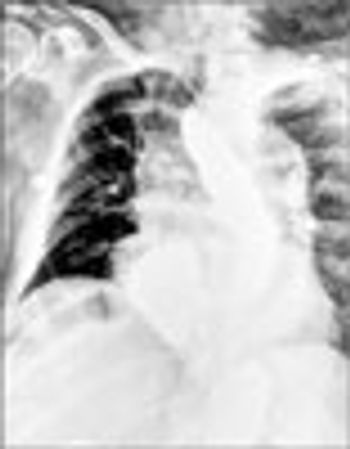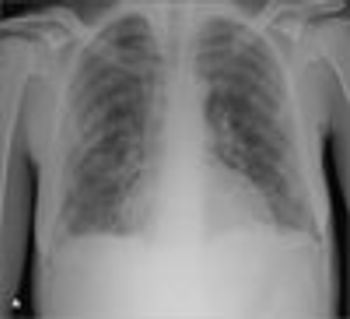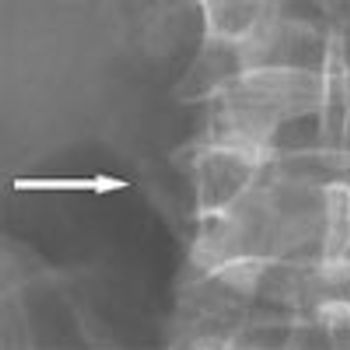
Open biopsy or fine-needle aspiration of a supraclavicular lymph node-especially the node on the left side of the neck where the thoracic duct exits-is a relatively easy way to diagnose malignancies.

Open biopsy or fine-needle aspiration of a supraclavicular lymph node-especially the node on the left side of the neck where the thoracic duct exits-is a relatively easy way to diagnose malignancies.

A 93-year-old man with known Alzheimer dementia has his admission physical examination on transfer to a geropsychiatric hospital unit due to behavioral difficulties. A language barrier and his stoicism minimize communication, but his devoted wife translates and recounts that he is not in any physical discomfort. Has sometimes needed oxygen treatment in the past.

Levothyroxine is one of the most commonly prescribed medications for the treatment of hypothyroidism as well as the suppression of thyroid neoplasms.1 Most patients with hypothyroidism require lifelong therapy with levothyroxine; therefore, the likelihood of drug interactions is high.

A 59-year-old woman presents with right-sided, nonradiating, “aching” chest pain that has been continuous and increasing in severity for the past 3 days. It began as a tightness that gradually became more painful; it is aggravated by palpation and movement and has not been relieved by acetaminophen.

For 10 years, a 32-year-old woman has had an asymptomatic rash on both sides of her neck. She is otherwise healthy.Do you recognize this rash?

Over the past 4 decades, our understanding of the role of elevated cholesterol in cardiovascular disease (CVD) has undergone radical change. During that time, we have moved from a belief that cholesterol does not matter and that atherosclerosis is an irreversible process to a strong conviction that treating elevated cholesterol, especially elevated low-density lipoprotein cholesterol (LDL-C), can slow and perhaps halt the progression of atherosclerosis. But it has been a slow process for several reasons. In the 1960s, the Framingham investigators demonstrated that elevated serum cholesterol is a risk factor for CVD.1

Increasingly severe dysphagia had bothered a 77-year-old woman for several months. By the time she sought medical attention, both food and liquids were sticking in the lower esophagus, leading to vomiting and weight loss.

For 3 days, a 45-year-old woman with HIV infection who was noncompliant with her antiretroviral medications had cough, yellowish sputum, fever, and dyspnea. She denied hemoptysis, weight loss, or recent hospitalization. She had a long history of heavy smoking and alcohol and intravenous drug abuse.

What should be added to the regimen of a patient with type 2 diabetes mellitus when initial oral therapy no longer adequately controls glucose levels?

An article in The New York Times succinctly summarized the World Health Organization's (WHO) recent report on the leading causes of death in the world: "As the world's population ages, gets richer, smokes more, eats more, and drives more, noncommunicable diseases will become bigger killers than infectious ones over the next 20 years."

A 55-year-old woman seen because of new lump under right side of her jaw; present for 24 hours. Associated neck discomfort causing dysphagia, and also a raspy turn to the voice; both much worse in last 12 hours. No dyspnea. No sore throat.

The family of a 49-year-old Chinese man brings him to the hospital after he becomes confused and disoriented. For about a week, the patient has had cough, cold symptoms, dizziness, and occasional vomiting.

Survivors of childhood cancer frequently present to primary care practitioners for a routine physical examination or for urgent care. Knowledge of the patient's cancer history and of the specifics of the treatment are essential to providing proper care and addressing his or her unique risks.

As part of his preparation for retirement, a 66-year-old executive undergoes a complete physical examination. He is in good health and has no symptoms to report. Along with other age-appropriate screening studies, you discuss testing for vascular disease with him.

My patient is a man in his early 70s who complains of lack of strength. His testosterone level is low, and his B12 level is low-normal.

To weigh patients whose weight exceeds the limit of your office scale, try the following maneuver.

Under what circumstances is it worthwhile to measure aldosterone levels in hypertensive patients? An increasing number of cardiovascular risk factors are being packaged into individual "epidemics."

Pain is a significant public health concern. In a prevalence study conducted in Australia, 17% of men and 20% of women reported chronic daily pain. A US study found that 13% of the total workforce had lost productive time during a 2-week period because of a pain condition. Headache, back pain, and arthritis pain headed the list of causes.

How effective is upper airway surgery in treating obstructive sleep apnea? The fallout from the growing obesity epidemic includes obstructive sleep apnea (OSA) syndrome. Although OSA may be considered a "specialty disease" (managed by pulmonologists, sleep specialists, otolaryngologists, and bariatric surgeons), the primary care physician bears the brunt of providing ongoing care.

Systolic hypertension is an independent risk factor for coronary artery disease, stroke, and end-stage renal disease. Nonpharmacological interventions for systolic hypertension include limitation of dietary sodium and alcohol intake along with weight reduction and aerobic exercise.

A 22-year-old woman has had chronic nausea, emesis with green vomitus, and diarrhea for the past 10 months. The diarrhea is frequent (about 3 to 8 times daily) and does not resolve with starvation.

An obese 61-year-old man with a history of heroin abuse was brought to the hospital after he had fallen onto his buttocks on a sidewalk. He was able to stand initially, but weakness and numb-ness in his legs rendered him suddenly unable to walk or prevent himself from voiding. He denied abdominal or back pain. His medical history included asthma, chronic obstructive pulmonary disease, and hypertension.

A 62-year-old man presents with painful cramps in his left lower leg that began about 6 months earlier and have recently become more frequent. The cramps occur with vigorous walking and cease when he stops for several minutes.

Identifying the cause of a persistent, asymptomatic aminotransferase elevation can be challenging. The possible diagnoses are many and varied. To narrow the differential, begin with a detailed history.

Treatment of hypertension can minimize both microvascular and macrovascular complications of diabetes and helps prevent nephropathy and cardiovascular events.